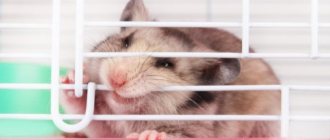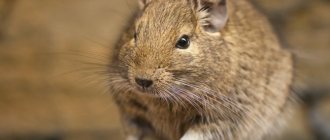Let's start with a couple of lines of encyclopedic information. Do you want to know where your animal comes from and what it is like? And then we’ll immediately talk about caring for Syrian hamsters.
One of the cutest pets.
Syrian hamsters (aka royal, golden, golden) were first mentioned in the 18th century, but a scientific description appeared only in 1836. They were discovered near Aleppo (Syria), which is why they got their name. After this, the rodent was considered extinct for a long time, because The stubborn Syrian hamster did not show itself to the researchers.
The cunning Syrian, foreseeing the future of toys for children and laboratory “consumables” (joke), migrated to the territories of modern Israel, Turkey, Iran, the Balkans, where he still lives safely.
The Syrian hamster hid for almost 100 years, and in 1930, an Israeli zoologist discovered a female with 12 hamsters. Only 4 survived, but this was enough for the rodent to become one of the most popular pets in our time.
What does a Syrian look like and how big will it grow?
Description. The Syrian hamster is a rodent belonging to the hamster family. It has a dense, “strongly built” body - the largest among domestic hamsters. The tail is small and inconspicuous. The predominant color is golden (we’ll talk about types of coats and colors below).
There are rumors that the Syrian hamster has 5 toes on its hind legs and 4 on its front legs. This is not true, there are also 5 on its front legs. It’s just that the thumb is so poorly developed that you can’t even see it.
The average length of an adult royal hamster is 12 cm, the weight of a male is 100-130 g, females - 110-140. But under conditions of good care and nutrition, some eat up to 12 cm in size and weigh 200 g. This is not the result of obesity, just a large animal - it looks almost like a guinea pig.
When choosing a sex, keep in mind that a mature male is more friendly and easier to tame. Female Syrian hamsters often have a bad and aggressive mood.
An adult male with a female in comparison (the female is bicolor).
How to breed hamsters. Preparing the female and male.
- The first thing to remember is that future parents should always live separately from each other. Otherwise, it could be fatal for one or both animals. Same-sex hamsters will also not get along together.
- If you are going to breed small hamsters, do not mix up the breeds. The Djungarian breed and the Campbell's hamster are very similar to each other, but serious problems may arise during crossing, and you may lose the female.
- It is important to provide hamsters with proper nutrition throughout their hamster life. If you feed, especially a female, just anything, this can lead to non-viable offspring, or she will eat them after birth. During pregnancy and nursing hamsters, the female needs to be given protein food more often, about every other day.
- Now separately about the females. They reach sexual maturity at two months, but this is too early an age for mating, since the body is not fully formed. Ideal age is 4 months. But you shouldn’t wait until six months. At the age of 12-13 months, females lose their ability to reproduce.
- In order to prevent wear and tear on the female’s body and get healthy offspring, it is necessary to observe pauses between matings of three months. It turns out that from one hamster you can get offspring three, maximum 4 times.
- Males. It's a little easier with them. They reach sexual maturity at 5 weeks and until the end of their lives. It is recommended not to breed the male too often so that the hamster does not lose its fertility.
Types of fur of the royal rodent
There are 3 main varieties of Syrian hamsters based on their coat type.
Satin . Classic shorthaired Syrians. Often the coat is "glossy", which makes the hamster shine in the light.
Long-haired . A detachment of royal rodents with long hair (individuals with a hairstyle 8-10 cm long are known). Often these Syrian hamsters are also called Angora or Persian. The abundant coat requires special care, so we have dedicated separate material on the website to Angora pets.
And I'm not the shaggiest yet!
Rex. Bred relatively recently, they are covered with thick wavy hair that looks like curls.
Colors of Syrian hamsters
The original color of the Syrians is golden (reddish-red, sometimes called peach). But now Syrian hamsters have been bred to come in almost any color. List of main colors of Syrian rodents:
- White (sometimes snow white is distinguished separately)
- Beige
- Yellow
- Smoked
- Copper
- Sable
- Black chocolate
- Grey
Classic color.
Appearance of Syrian hamsters
The body of these hamsters is stocky, reaching 30 centimeters in length.
The paws are short, the ears are of medium length and round in shape, the muzzle is small, the eyes have the appearance of beads, the tail is so small that it is almost invisible from under the fur.
The belly of the Syrian hamster is light in color, and the color of the back is brown-gray or ocher-gray. The most common color is golden. There are 4 toes on the front paws, and 5 toes on the hind paws. A special feature of hamsters is the presence of cheek pouches, which are used to transport food.
Caring for a Syrian Hamster
Proper maintenance and care of a royal hamster consists of:
- Have a comfortable home
- Physical activity
- Hygiene
- Good nutrition
- Protection from stress
- Veterinary treatment
What should a pet's house (cage) be like?
Recommendations for house size for the Syrian breed vary greatly, we will try to answer this question as simply as possible. Choose a cage of such a size that maintenance is easy and it can accommodate:
- House for the night
- Toilet
- Utensils for food
- Drinking bowl
- running wheel
Place accessories freely so that the toilet and eating area are as far apart as possible. Additional options in the form of a labyrinth or a second or third level will make the adult pet’s home more comfortable.
What to prefer: a cage, an aquarium, a terrarium or something else? The most suitable option is a cage, and it is easier to care for than other options. An aquarium of sufficient size is also good, but the cage has better air circulation. Good options include a terrarium or a homemade glass shelving unit.
Do not keep your Syrian hamster in a jar or cardboard box. They are too crowded and the small rodent has to sleep in its own excrement. And the lack of “sports equipment” will greatly affect the baby’s health (we will cover this issue a little lower).
Place the house in a quiet place - caring for a Syrian rodent involves the absence of noise. Sudden loud noises will cause him stress and possibly inappropriate behavior. Those. the living room and kitchen are not suitable. The bedroom is also not an option: the hamster is a nocturnal animal and will not let you sleep. One way out is to leave the cage in the bedroom during the day and move it to the living room at night.
Why does a Syrian hamster need to exercise?
In the wild, a hamster runs up to 12 km per night - there is no feeder, and food must be looked for. At home, with proper care, there is plenty of food, it’s not far to run for it. As a consequence - obesity and all the ensuing consequences (problems with the cardiovascular, endocrine systems, musculoskeletal system). Simply put, it will become more difficult for the pet to move, a heart attack is possible, and the likelihood of diabetes increases (although it is much less than in dwarf varieties).
This is why wheels and labyrinths are placed in the cage. You can also use a special walking ball for hamsters.
We strongly do not recommend walking on the street. Open spaces, noise, sunlight will lead to severe stress after the comfort of an apartment. There is also the possibility of picking up parasites somewhere on the lawn or simply losing a nimble little one.
Luxurious apartment with a gym for a rodent.
Hygiene for a healthy hamster
The royal hamster will definitely equip a toilet in the house. You should not try to accustom him to a certain place - it will be easier to care for if you see where he chooses a latrine, and only then install a kennel and a bowl of food as far away as possible.
There should be filler on the floor of the cage, the layer thickness is 2 cm. Typically used:
- Sawdust
- Corn filler
- Granulated
- paper
Experiment for yourself, which is more convenient and fits your budget. Pieces of paper are a cheap care option, but choose ones without fragrances or other additives. Your pet may develop allergies, and in the worst case, poisoning when he tries to eat the bedding. The main thing is not to use cotton wool or other fibrous materials - the baby may simply get entangled and even suffocate.
The filler also requires regular maintenance - change it at least once a week, preferably 2. You can read in detail about how to choose a filler and how they differ in a separate article on the website.
At least once a week, clean the cage and do a wet cleaning. When caring for the house, do not use detergents with a strong smell - the Syrian hamster may refuse to return to the house. Don't forget to take care of your pet's pantry: don't throw everything away, but remove perishable foods.
The correct “ground floor” of the house with bedding.
About bathing a hamster
The Syrian hamster lives in the steppe. He not only doesn’t like water, he hates it!
Do not resort to water procedures unless absolutely necessary. But if you really have to (a quickie gets into something, it happens), read carefully about how to bathe a rodent here.
The Syrian hamster handles hair care itself - with the help of its tongue and paws. If you want to help him care for him, place a container of sand (sold in pet stores). It is with this “bathing” that Syrian pets clean themselves in nature.
How do Syrian hamsters reproduce at home?
Caring for a hamster is very simple, even children can handle it. You just need to explain all the nuances of feeding and care. Breeding Syrian hamsters at home requires responsibility and care.
Room equipment
It is necessary to choose a place to place the cage so that it is spacious, away from noise and dust. The cage should be located away from direct sunlight. It is necessary to frequently ventilate the room, but at the same time strictly avoid drafts.
In order for the reproduction of Syrian hamsters to be successful, it is necessary to prepare several cages:
- A large and spacious cage where the female will be with her offspring after giving birth. In this cage you need to equip a queen cell where the birth will take place. You need to add a small layer of sawdust to the bottom. It is extremely necessary to arrange an active area so that there is a place where kids can frolic. The spinning wheel, rungs and ladders are perfect for outdoor activities.
- Cage or box for mating. Here you can get by with a small box; it needs to be free of distracting objects (wheels, ladders). You can add sawdust or special filler to the bottom. It is important to place the box where it is inaccessible to children, cats, dogs and other pets.
- An additional cage where, if necessary, the Syrian hamster can be placed in case of any aggression from other animals.
Purchasing rodents
A lot depends on the choice of partner for mating. Breeding Syrian hamsters is a responsible matter and must be taken seriously so as not to endanger the lives of the entire Syrian hamster family. A pair of the opposite sex should be of the same breed as your pet. Hamsters should not be closely related to each other, otherwise brother and sister may produce weak offspring with signs of pathology and physical inferiority.
It is important to be able to distinguish a male Syrian hamster from a female. Only healthy rodents without diseases or transmittable infections are allowed for mating. The coat of the purchased animal should be shiny, thick and without bald spots. The eyes and nose should be clean and free of discharge. It is also worth paying attention to the emotional state of the hamster. In a normal state, the animal behaves actively, showing interest in everything new, without being afraid of an outstretched hand. However, too energetic behavior of an animal should alert you, as well as too apathetic behavior.
To give your pet time to get used to a new territory, you need to buy a Syrian hamster at a young age. After purchasing a partner, hamsters should be kept separately from each other so as not to suffer as a result of aggression from the partner. Mostly females show aggression, not allowing the male to approach them. They are favorable to their partner only during estrus, which lasts 3-4 days.
Syrian hamster: reproduction
Syrian hamsters reach sexual maturity when they are between 1 and 2.5 months old. But at this age it is not recommended to mate, since the delayed physical development of the female can negatively affect the bearing and feeding of offspring. The female may not have enough milk for large offspring. Therefore, it is worth involving a female in breeding for the first time no earlier than when she reaches three months of age. If your first birth occurs after she is six months old, there is a risk of complications during pregnancy and childbirth. The male is capable of healthy fertilization at the age of 3 months to one and a half years.
Before mating begins, you need to find out when the female is in heat; it is on such days that you can place a male with her. The main signs of estrus in a female Syrian hamster are similar to other animals. She becomes more active than usual and can stand up, arching her back and spreading her paws. Under the tail you can notice a mucous discharge with a pungent odor. Syrian hamsters are nocturnal animals; they are active mainly at night, including mating. Estrus can begin in the evening and last until the morning. It is necessary not to miss this moment and place a male with her. The next chance will be only in 4-5 days. If you are sure that the right moment has come right now, you need to carefully bring the male to the female. After sniffing each other, the girl can stand up, thereby showing her consent. Now you need to leave the couple in a quiet, calm place for the duration of mating and not disturb them. Half an hour will be enough for conception; during this time you need to be careful and, if the female becomes aggressive, immediately isolate the male from her. There have been cases when a female bit her partner to death.
What to feed your Syrian hamster?
The Syrian diet in nature consists of:
- Seeds and cereals (the basis of rodent nutrition)
- Herbs
- Insects
In your home life, also try to adapt to this list.
A mixture of grains and seeds is the main thing you need to give your pet. An excellent option is ready-made dry food for hamsters. If the manufacturer has enriched the composition with vitamins and minerals, even better.
Do not buy food for other rodents and animals. Some substances that are harmless to large pets can poison the baby.
If you prefer to control the composition of the food yourself, and caring for the animal gives you pleasure, here is a simple video instruction for preparing the mixture.
The most common set is oats, millet, corn, and some seeds.
You can also add some nuts to the food (except for almonds and Brazilian almonds - they contain a high concentration of substances dangerous to rodents).
The Syrian hamster will also benefit from greens (lettuce, dill). Eliminate onion and garlic shoots and sorrel from your diet.
In season, add fresh vegetables, fruits and berries to your menu. But this should be done carefully. The Syrian is not as prone to diabetes as the Djungarian, but still avoid overly sweet fruits and starchy vegetables. Use the glycemic index table of foods - very useful information for those who care for the Syrian animal. Try not to give foods that have a GI of more than 50 - an excess of easily digestible carbohydrates.
Don't forget about protein. Buy ready-made dried insects or feed your pet 1-2 times a week with the following products of your choice:
- Egg white
- Boiled chicken breast
- Boiled lean white fish
Lactating and pregnant females, as well as their offspring, need special care and more protein - give protein foods a little daily.
Syrian hamsters' teeth grow throughout their lives. Place a mineral stone or piece of wood in the cage to grind down the fangs.
We talk in detail about what you can and cannot feed your golden hamster in a separate article on the website.
When in season, berries are an excellent addition to your diet.
Caring for Hamsters
After birth, during the first week, hamsters cannot be picked up. Having smelled someone else's scent on the cubs, the mother will most likely eat them. The desire to pet the babies should be postponed until the fur appears, which will happen in a week.
For the convenience of mother and babies, it is recommended to put a napkin or soft paper in the cage, with which the female covers the cubs when leaving them to eat. 5 days after birth, the cubs can already squeak demandingly; on the twelfth day of life, the hamsters begin to slowly crawl out of the nest and explore the surrounding space. Babies' eyes open only 2 weeks after birth, and around this time they begin to feed on their own. At this time, you can put a little porridge and carrots, grated on a fine grater, in the baby's cage. A healthy mother with a large amount of milk can feed her cubs for up to a month, and this has a positive effect on the health and strength of the hamsters.
At the age of one month, hamsters are placed in cages: boys in one cage, girls in another. This is done in order to prevent early unwanted pregnancy. Hamsters live in their new home for another 1-2 weeks. During this period, hamsters are tamed and played with. Hamsters can move to a new home with new owners at the age of 5-6 weeks.
How to avoid stress?
Why avoid it at all? When a pet is stressed, its behavior changes unpredictably. He may stop eating, may behave aggressively or, conversely, indifferently. Caring for a Syrian under stress becomes very difficult.
We have already listed the main stress factors, let’s summarize them:
- Noise, especially loud
- Daylight
- Water treatments
- Other hamsters and animals
Hamsters are solitary animals; they unite only during mating. Remember this, and do not try to “make friends” of the Syrian with other hamsters and other pets.
It is also worth gradually accustoming the golden handsome man to your hands. The Syrian is the most peaceful type of hamster, but even among them there are quarrelsome characters. There is no point in rushing things and expecting mutual love from the first days.
Read more about taming and other training on our website.
That's how stressed I am... Don't hurt the rodent!
Syrian Hamster Health
Common health problems in the king hamster:
- Obesity
- Eye diseases
- Gastrointestinal disorders
- Skin diseases
- Injuries
If you notice external signs of illness (inflammation, scratching, diarrhea) or your pet’s behavior has changed (became lethargic, makes strange sounds, does not eat), immediately contact a veterinarian (a specialist in rodents is called a ratologist). Under no circumstances should you treat it yourself, otherwise there may be no one to care for you.
To avoid injury, keep an eye on the animal while walking around your apartment or house. Hamsters live on plains, so they don’t understand what height is. Before you know it, your pet will fall off the back of the sofa and break its leg.
We wrote in detail about the diseases of Syrian hamsters and their care in a separate article.
Don't panic! The doctor knows what to do.
Care and maintenance of Syrian hamsters
Syrian hamsters are very popular both in our country and around the world. Most likely, this is due to the unpretentiousness of maintenance, the resistance of the hamsters’ immunity, as well as their attractive appearance.
How many hamsters to get
The peculiarities of keeping them are that these animals prefer to lead an isolated lifestyle, while becoming attached to a certain territory, which they fearlessly defend. You need to know this in order to decide on the number of animals you plan to have. Therefore, they cannot be kept even in pairs, not to mention entire groups of animals. At the same time, it should be noted that there is a type of social hamsters - these are Roborovsky hamsters, which can be kept in whole groups without any problems.
Selection and filling of the cage
Syrian hamsters are relatively large in size, so a small cage is not suitable for keeping such a pet. In addition, the size of the cage must be such that it can accommodate a wheel with various labyrinths, as well as other accessories.
The best option can be considered a cage with dimensions of 37x27 cm and a height of about 36 cm. If the cage has two floors, then this is even better, since it is more convenient and more comfortable for the animal.
Features of the cell include:
- It is not necessary that the cage have several floors, but the main thing is that its dimensions are optimal.
- Dimensions should not be less than 50x30 cm.
- If the cage is too small in size, the animal may suffer from lack of movement, which leads to obesity.
- The second floor should be located at least 30 cm from the bottom of the cage.
- The door dimensions should be optimal, but not small.
- The distance between the rods is no more than 1 cm.
- It is better to get a cage that has a solid tray rather than a mesh one.
The hamster's home should be equipped with a special wheel, which will act as a gymnastic apparatus, and the bottom should be filled with sawdust, which can absorb moisture, as well as foreign odors.
Important point! The more game elements there are in the cage, in the form of a wheel, various manholes, steps and ladders, the more active the pet will behave.
Do not cover the bottom of the cage with cotton wool or paper. An excellent play element for a hamster in his home is a wooden driftwood with a smooth surface.
Rules of care and hygiene
Keeping a pet hamster requires deep cleaning of the entire home once a week. To do this, the upper part of the cage is removed and any remaining food, as well as bedding, is removed. As a daily activity, it is advisable to carry out partial cleaning, replacing the remaining feed and bedding that has become unusable.
After general cleaning, disinfection measures are mandatory using safe substances, after which the cage is wiped dry with a cotton cloth or paper towel. In addition, all additional elements of the cage, including bowls and drinking bowls, require regular washing. Cleanliness is the key to your pet’s health.










